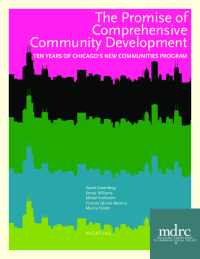The Promise of Comprehensive Community Development
Ten Years of Chicago’s New Communities Program

From 2002 to 2012, the John D. and Catherine T. MacArthur Foundation provided $50 million to the Local Initiatives Support Corporation of Chicago (LISC Chicago), to implement the New Communities Program (NCP). NCP supported community organizations in 14 neighborhood areas to convene local partners to define a “quality-of-life plan” for each neighborhood. It then provided grants to carry out these plans, which addressed a variety of local challenges, including unemployment, struggling schools, and gang violence.
MacArthur’s investment was informed by research that residents have better outcomes when they live in neighborhoods where individuals and organizations come together to respond to local challenges. For its part, LISC Chicago wanted to help local agencies learn to work together to resolve long-standing antagonisms when they existed and to facilitate implementation of diverse community improvement projects. This report describes the challenges that NCP faced, the extent to which it achieved its goals, and the implications for similar initiatives. As a model for recent federal policy, the NCP experience is particularly important to consider.
Key Findings
- Nearly 850 varied improvement projects — many with multiple components — and over $900 million in total funding (grants and loans) were reported among the 14 neighborhood areas over 10 years. MacArthur’s investment was always intended to leverage additional resources. NCP succeeded in connecting many groups to citywide and national funders and also resulted in partnerships across neighborhoods. Neighborhoods with multi-issue, high-capacity lead agencies and strong local partners tended to leverage the most additional funds.
- NCP helped to improve collaborative partnerships among local agencies. In neighborhoods where trust and cooperation were better established among community groups at the beginning of NCP, interorganizational relationships deepened over the course of the initiative. But where there were histories of antagonism among community partners, relationships improved during the periods of planning and early implementation, although it proved difficult to sustain both trust and collaboration over time.
- It was rare for interorganizational relationships to promote collaborative, coordinated programming across the many projects supported by NCP, and it was rare for NCP networks to add value to the implementation of small, individual projects. In some significant cases, however, when guided by a high-capacity lead agency, these organizational partnerships could tap into new funding streams and promote strong collaborations.
Building on the NCP experience, MacArthur and LISC have launched a next-generation initiative, “Testing the Model” (TTM). Like the original NCP model, TTM attempts to deliver resources to neighborhoods, but these investments are explicitly aimed at achieving longer-term change by concentrating efforts on a single issue or domain. Future work will report on the implementation of TTM and how neighborhoods are changing in these targeted domains.






